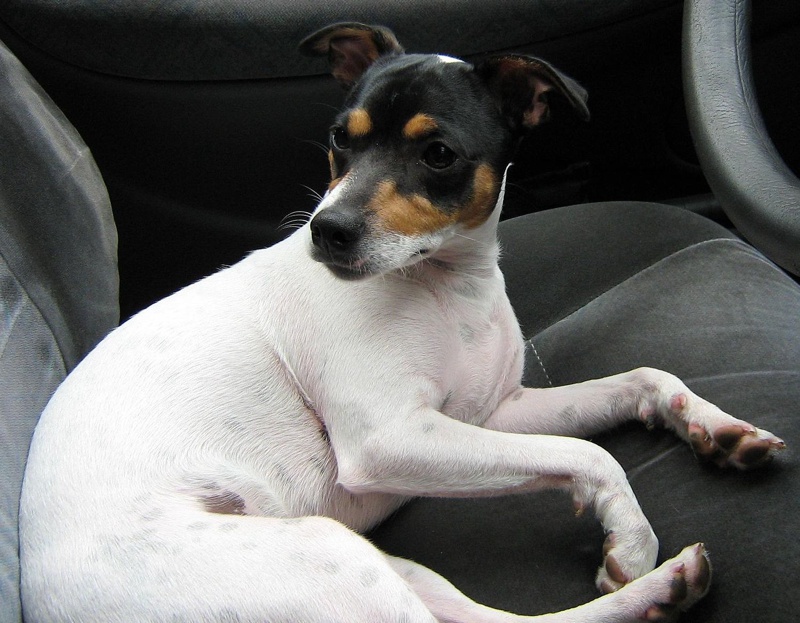Chilean Terrier

This South American breed is the result of mixing the English Fox Terrier that had arrived on ships from Great Britain with a mixture of local Chilean dogs. Initially used to hunt vermin, they are now most often kept as family pets. Owners appreciate their confident nature and the affection they show their families. An attentive watch dog, nothing goes unnoticed when the Chilean Terrier is about.
Fine-boned though sturdy, the Chilean Terrier bears a close resemblance to the smooth-coated English Fox Terrier. Their fur is predominantly white, though most will have brown and black markings. While some will have a natural bob-tail, others will have had their tail artificially cropped.
About & History
The Chilean Terrier is also known as the Chilean Fox Terrier or the Ratonero. It is considered to be the only internationally recognised Chilean breed in existence. Originating from breeding the English Fox Terrier with a number of local South American breeds, this dog has been kept as both a rat hunter and a much-loved family pet for several centuries.
While it is difficult to confirm exact dates, most agree that the Chilean Terrier was first bred in the early 1800s. Once they had been imported, local people admired the British Fox Terrier for its tenacity and vermin killing instincts. While fox hunting was not a recognised sport, the newly introduced breed was soon put to good use hunting smaller prey. Chileans also liked the fact that the British Fox Terrier was a small dog that could adapt well to urban life and did not need a large amount of food to thrive. As well as having a somewhat different physical appearance, the Chilean Terrier is more suited to the South American climate than the British Fox Terrier and can cope better in the heat.
Surprisingly, it was not until the breed was popularised within a cartoon strip that was developed in 1949 that they became well-known. ‘Washington’ is the name of the little Chilean Terrier that stars in the strip called Condorito and is a favourite of many children.
At the turn of the century, breed fanciers began a consorted effort to standardise the breed and protect them. While the FCI, AKC and UKC do not yet recognise the Chilean Terrier, the Chilean Kennel Club have categorised them within their Terrier group.
Appearance

Not dissimilar to today’s Smooth Fox Terrier, the Chilean Terrier seems to have inherited most of its physical characteristics from its British side. More so than other pure-breeds, there is still a good deal of variability within the Chilean Terrier breed and they have not been standardised to the same extent as other well-known terriers.
An elegant dog with slender bones and fine features, the Chilean Terrier should have long and lean limbs with a well-proportioned rectangular-shaped body. Their triangular head narrows towards the muzzle and they have characteristic semi-prick ears, which hang sweetly each side of their face. Their gentle brown eyes are their most prominent facial feature and lend them a kind expression. Most have a very short ‘bob’ tail though some will have a longer tail, more similar to that of the Jack Russell Terrier.
Their fur is short, straight and mostly white, though they will have black and tan markings, usually on their head. Some will have dark splotches on their body or tail, which should ideally be symmetrical. Most breed members weighh between 4kg and 8kg and will measure from 28cm to 38cm at the withers.
Character & Temperament
Most agree that while the Chilean Terrier will have the plucky, courageous spirit of other Terriers, they can be less ‘sharp’ and somewhat more laid back than one might expect. They enjoying being around their family and will show them a good deal of affection though will tend to still retain some independence and rarely get over-attached. They can do well with children but may become rambunctious when over-excited so should be monitored in their presence.
Having been bred for many years to aggressively pursue prey and kill it, these dogs do have a heightened prey drive and can be incredibly determined when it comes to making a kill. These natural instincts make the Chilean Terrier unsuitable to house alongside small pets. Anecdotally, many individuals can be dog aggressive unless raised alongside other dogs from a young age.
An excellent watch dog, the Chilean Terrier will attentively patrol their property and ensure their owner knows immediately if anyone new has arrived. Their small stature means they are not well-suited to work as a guard dog, however.
Trainability
Curious, cheerful and highly intelligent, the Chilean Terrier can be a real pleasure to train and thoroughly enjoys learning new tricks and showing off its new skills. In the wrong hands, some dogs can be quite stubborn so do require a dedicated trainer from an early age that knows how to deal with the potentially independent and willful streak of the Terrier.
To overcome potential issues of dominance and dog to dog aggression, intensive training and socialisation programmes should begin from a young age and be maintained throughout their lifetime.
Health
With no health studies having been performed on this little Chilean dog, it is difficult to say with much certainty which conditions we should be monitoring for within the breed. Having said that, there are certain diseases that we suspect to be more prevalent within the population that we should be keeping an eye out for.
Patellar Luxation
Patellar luxation, or kneecap dislocation, is an orthopaedic condition common to many terrier breeds. When a kneecap is constantly popping in and out of place, it is inevitable that the joint will become arthritic in later life, causing the dog some degree of discomfort.
Surgery is advised for those whose lives are significantly impacted by the condition. After surgery, most dogs will be put on a rehabilitation programme that may consist of controlled exercise, physiotherapy and hydrotherapy.
PRA (Progressive Retinal Atrophy)
PRA is an ocular condition that is known to be passed on genetically. In affected dogs, their retinal cells degenerate over time. While in the initial stages dogs may only show signs of being visually impaired in the dark, as the disease progresses, the blindness worsens and dogs will eventually lose all of their eyesight. DNA tests have meant that parents can be tested before breeding to ensure they are not carriers of the disease.
Legg Calvé Perthes Disease
In dogs affected with Legg Calvé Perthes, the top of their leg bone will spontaneously degenerate and their hip is no longer able to function adequately and develops local osteoarthritis. As well as a dog developing lameness and pain, their local muscles will atrophy. X-rays of the joints can diagnose the condition. If surgery is advised, a femoral head and neck excision or a total hip replacement will be performed.
Exercise and Activity Levels
While small, the Chilean Terrier very much enjoys keeping active. They benefit from a couple of 30 minute vigorous walks or runs each day and also enjoy being allowed to scent and trail. On top of letting off steam outdoors, they should be provided with lots of mental stimulation in the form of canine puzzles and obedience training to keep their brain ticking over.
Without adequate physical and/or mental stimulation, it is likely that the Chilean Terrier will start to develop some undesired behaviours. Incessant barking, furniture chewing and digging may all develop in bored dogs when left alone for too long without any form of stimulation.
Grooming
The very short coat of the Chilean Terrier is particularly low maintenance and should be brushed once weekly. At the same time, their ears can be checked for any waxy build-up.
Some dogs may experience issues with blocked anal glands. Owners may notice them scooting on their bottom or looking behind themselves every so often. While passing regular, firm stools and maintaining a lean body condition can help to keep the anal glands in good working order, some may require manual emptying of their gland every few months to prevent impaction.
Famous Chilean Terriers
Washington is probably the best-known Chilean Terrier, though he is a fictional character in the cartoon strip, Condorito, rather than a real-life dog!
Cross-Breeds
While the Chilean Terrier is itself a cross between the English Fox Terrier and local Chilean breeds, there are no specific Chilean Terrier crosses being bred today.

